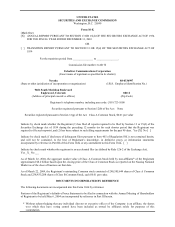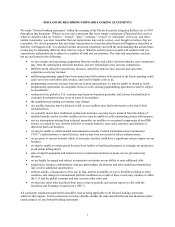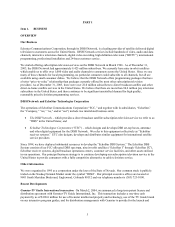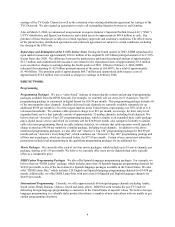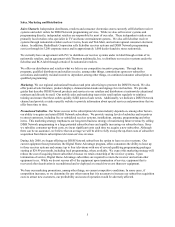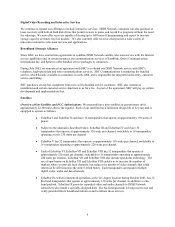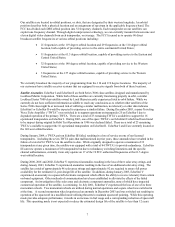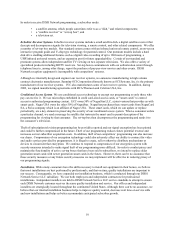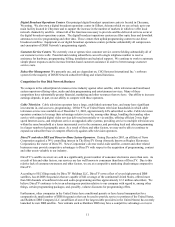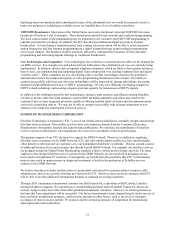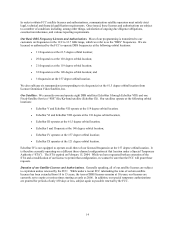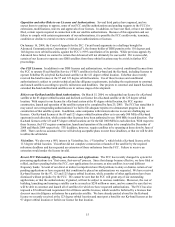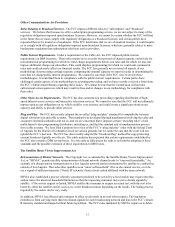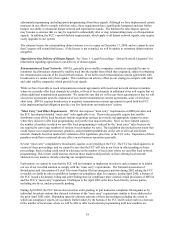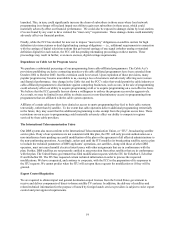Dish Network 2003 Annual Report Download - page 14
Download and view the complete annual report
Please find page 14 of the 2003 Dish Network annual report below. You can navigate through the pages in the report by either clicking on the pages listed below, or by using the keyword search tool below to find specific information within the annual report.9
Certain Other Risks to Our Satellites. Meteoroid events pose a potential threat to all in-orbit geosynchronous
satellites including our DBS satellites. While the probability that our satellites will be damaged by meteoroids is
very small, that probability increases significantly when the Earth passes through the particulate stream left behind
by various comets.
Occasionally, increased solar activity poses a potential threat to all in-orbit geosynchronous satellites including our
direct broadcast satellites. The probability that the effects from this activity will damage our satellites or cause
service interruptions is generally very small.
Some decommissioned spacecraft are in uncontrolled orbits which pass through the geostationary belt at various
points, and present hazards to operational spacecraft including our direct broadcast satellites. The locations of these
hazards are generally well known and may require us to perform maneuvers to avoid collisions.
Satellites under Construction and Leased Satellites. EchoStar X, which is expected to be launched during 2005, is
being built by Lockheed Martin Commercial Space Systems and will be used for expanded DISH Network video
services.
During March 2003 we entered into a satellite service agreement with SES Americom for all of the capacity on a
new FSS satellite, which may be located at the 105 degree orbital location or certain other orbital locations. We also
agreed to lease all of the capacity on an existing in-orbit FSS satellite at the 105 degree orbital location beginning
August 1, 2003 and continuing at least until the new satellite is launched. We intend to use the capacity on the
satellites to offer a combination of programming including local network channels in additional markets, together
with satellite-delivered, high-speed internet services. During August 2003, we exercised our option under the SES
Americom agreement to also lease for an initial ten-year term all of the capacity on a new DBS satellite at an orbital
location to be determined at a future date. We anticipate that this satellite will be launched during the fourth quarter
of 2005.
During February 2004, we entered into two additional satellite service agreements for capacity on FSS satellites.
Pending the successful launch and entry into service of the previously described new FSS satellite, the satellite
under the first of these agreements is scheduled for launch during the first half of 2005. We intend to use this
additional satellite as backup in the case of any unexpected events related to the initial operational deployment of the
satellite at the 105 degree orbital location, and may also utilize the satellite to offer local network channels in
additional markets, together with satellite-delivered, high-speed internet services. The satellite under the second of
these agreements is planned for launch during the second half of 2006 and is contingent upon, among other things,
obtaining necessary regulatory approvals. There can be no assurance that we will obtain these approvals or that the
satellite will ultimately be launched. It is our intent to use the capacity on this satellite to offer additional value-
added services.
Components of a DBS System
Overview. In order to provide programming services to DISH Network subscribers, we have entered into agreements
with video, audio and data programmers, who deliver their programming content to our digital broadcast operations
centers in Cheyenne, Wyoming and Gilbert, Arizona, via commercial satellites, fiber optic networks or microwave
transmissions. We monitor those signals for quality, and can add promotional messages, public service
programming, advertising, and other information. Equipment at our digital broadcast operations centers then
digitizes, compresses, encrypts and combines the signal with other necessary data, such as conditional access
information. We then “uplink” or transmit the signals to one or more of our satellites and broadcast directly to
DISH Network subscribers.


